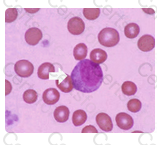Which of the following is most likely to interact with arterial walls, leading to deposition of cholesterol, and initiating or worsening atherosclerosis?
The cell shown in this image is a myelocyte. Myelocytes typically have an eccentric nucleus with cytoplasm similar to a mature neutrophils with a slightly bluer tint due to the cell's immaturity.

Myelocytes have both primary and secondary granules present in the cytoplasm. The nucleus is less mature and therefore has a loose chromatin clumping pattern.
Identify the cell in this illustration indicated by the arrow:
In this case, the pH may become more alkaline, perhaps above 8.0, if the bacteria in the sample are proliferating during the extended room-temperature wait time.
A urine specimen was collected at 6:00 a.m. and remained at room temperature until it was received in the laboratory at 3:30 p.m. How may the pH of the specimen be affected by the extended time at room temperature if bacteria are present in the specimen?
Escherichia coli and Klebsiella pneumoniae are two good quality control choices for the indole test. E. coli is indole positive, while K. pneumoniae is indole negative. A positive reaction is noted when there is a red layer at the top of the tube after the addition of Kovács reagent, while the negative result is a lack of color change in the top of the tube after the addition of Kovács reagent.
Which one of the following combinations of organisms would be appropriate positive and negative controls to verify the specific test functions listed?
DAT ( Direct Antiglobulin Test ).
When AHG or Coombs serum is used to demonstrate that red cells are antibody coated in vivo, the procedure is termed:
Acute hemolytic transfusion reactions are most commonly due to ABO-incompatible blood being transfused to a recipient with naturally occurring ABO alloantibodies (anti-A, anti-B, anti A,B).
Acute intravascular hemolysis as the result of a blood transfusion is most often associated with which of the following causes?
Cholesterol levels do not fluctuate as triglycerides, fatty acids, lipoproteins, and chylomicrons do after an individual eats a meal. This is the reason that patients are told to fast; the laboratory needs a fasting sample to determine a lipid profile or panel which includes the latter four components.
Which of the following lipid tests is LEAST affected by the fasting status of the patient?
HLA-DR is a MHC class II(major histocompatibility complex) surface receptor on the cellular surface which is encoded by the human leukocyte antigen complex, or HLA.
DR antigens are found in which of the following systems:
What two glycoproteins are expressed on the surface of influenza A viruses and are used for subtyping of the viruses?
The purpose of protective isolation is to protect:
A beam splitter is employed in a dual beam spectrophotometer.
Which of the following is not a component of a basic single beam spectrophotometer:
Kell, Kidd, and Duffy are usually warm reacting IgG antibodies. The most common P system antibody is anti-P1, which is a frequently naturally occurring low titer IgM antibody, seen in most P2 individuals.
Blood bank
Which of the following blood groups is most frequently associated with cold agglutinins:
The role of provider-performed microscopy (PPM) is the
The difference between plasma and serum is that:
Match each virus with its appropriate nucleic acid content.
1. Paramyxovirus
2. Rhabdovirus
3. Poxvirus
4. Orthomyxovirus